Notes: Aldergrove station was situated on the 20 mile Lisburn – Antrim branch which was opened by the Dublin & Antrim Junction Railway (DAJR) on 13 November 1871.It connected the Belfast – Portadown line of the Ulster Railway (UR) at Knockmore Junction (Lisburn) to the Belfast – Coleraine line of the Belfast & Northern Counties Railway (B&NCR) at Antrim. At the time of opening there were 5 stations on the line including Aldergrove.
The station at Aldergrove was opened with the line on 13 November 1871. It was located on the eastern edge of its namesake, a small settlement, 13¼ miles to the north of Knockmore Junction.
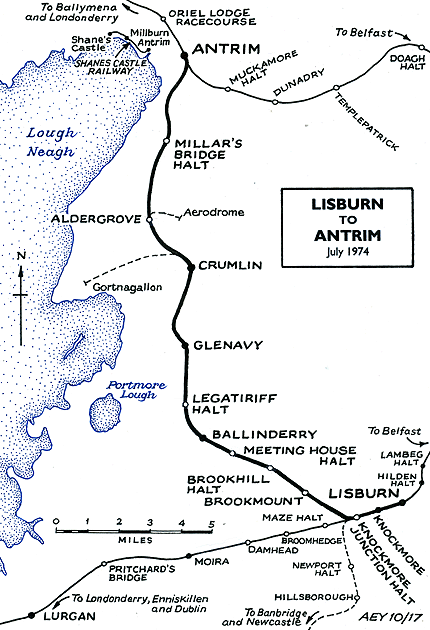 Aldergrove station was on the north side of a lane that passed over the line on a bridge. The line was a single track railway built to the Irish standard gauge (5ft 3inch) and the station was provided with one platform located on the western side of the line. The station had goods facilities in the form of a siding located at the rear of the platform towards its northern end. There was also a cattle pen. Aldergrove station was on the north side of a lane that passed over the line on a bridge. The line was a single track railway built to the Irish standard gauge (5ft 3inch) and the station was provided with one platform located on the western side of the line. The station had goods facilities in the form of a siding located at the rear of the platform towards its northern end. There was also a cattle pen.
Passenger services were operated by the UR mostly running between Belfast Great Victoria Street and Antrim.
On 1 April 1876 the UR was absorbed into the Great Northern Railway Ireland (GNRI) and from that date they operated the train services. In 1879 the DAJR was taken over by the GNRI.
In 1882 the GNRI improved the facilities at Aldergrove. A single storey brick built building was provided built to a design that had been developed for the GNRI by architect William H Mills.
The December 1895 timetable showed 4 trains in each direction Monday to Saturday and a train each way on Sundays.
The 1904 Railway Clearing House Handbook of Stations listed Aldergrove as being able to handle passengers, parcels, general goods and livestock.
In 1916 an aerodrome was built at Aldergrove by the War Department. It was located 2 miles to the east of the station and to assist in its construction a branch line was built. It was 3 miles long and diverged from the main line just to the north of the station. After the aerodrome was completed the branch was used for military purposes but it closed in 1918.
The July 1922 timetable showed the same level of service as there had been in 1895 as seen in the table below. The DAJR Up direction had been towards Knockmore Junction and the Down to Antrim. By 1922 the GNRI had reversed the direction protocol for the line. Up was to Antrim and down to Knockmore Junction.
| Up Trains - July 1922 |
Destination |
Down Trains - July 1922 |
Destination |
| 9.06am |
Antrim |
7.55am |
Belfast Great Victoria Street |
| 12.24pm |
Antrim |
10.30am (Monday and Tuesday Only) |
Belfast Great Victoria Street |
| 3.05pm (Saturdays Only) |
Antrim |
10.44am (Monday and Tuesday Excepted) |
Belfast Great Victoria Street |
| 4.13pm (Saturdays excepted) |
Antrim |
1.50pm |
Belfast Great Victoria Street |
| 7.20pm |
Antrim |
6.00pm |
Belfast Great Victoria Street |
| Sundays |
|
Sundays |
|
| 10.35am |
Antrim |
7.54pm |
Belfast Great Victoria Street |
In 1922 following the Irish War of Independence (1919 – 1922) 1922 the island of Ireland was divided into two separate states, The Irish Free State (after 1948 Republic of Ireland) and Northern Ireland. The GNRI network was located in both countries which caused it some difficulties. The Antrim branch was entirely within Northern Ireland so little changed with regards to its train services.
The 1 July 1928 GNRI timetable showed that there were still 4 trains in each direction Monday-to-Friday but there was an extra up train on Saturdays. The sunday service had been increased there being 2 trains each way.
During the 1920s and 1930s the GNRI suffered competition from road transport. Local bus services hit passenger receipts and private hauliers using lorries had an impact on freight.
The aerodrome branch was lifted in the early 1930s.
The Second World War (1939 – 1945) was a busy period for the GNRI and traffic levels increased significantly. In 1942 a passing loop was installed at Aldergrove and a platform was added to service it. An additional siding was also added on the east side of the line. The new platform became the Down direction platform and the original platform became the Up. A signal box was also opened at this time. It was located to the north of the station on the west side of the line. The station also gained an old coach body around this time which served as a waiting room. It was located on the Down platform to the north of the original building.
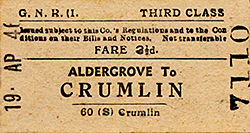 During the war additional trains were run to Aldergrove for military personnel and aerodrome workers. One such service was run by the London Midland & Scottish Railway Northern Counties Committee (LMS NCC) a successor company of the B&NCR). Their working timetable supplement of 12 April 1942 showed a Monday-to-Friday departure for Cookstown Junction at 5.50pm. This train arrived at Aldergrove from Antrim as an empty stock move at 5.48pm and was given only 2 minutes to turn around. On Saturdays the departure for Cookstown was at 12.43pm the stock having arrived from Antrim at 12.40pm. On Sundays there was an LMS NCC train from Ballymena which arrived at 9.00am. It departed as empty stock at 9.10am and ran back to Ballymena. Empty stock was then departed from Ballymena at 5.10pm and arrived back at Aldergrove at 5.48pm. This stock formed the 5.50pm passenger service from Aldergrove to Ballymena which was reached at 6.40pm. There are no passenger arrivals listed on weekdays and they certainly would have been required. They were probably operated by the GNRI and would therefore not appear in the LMS NCC working timetable (click here to see the working timetable supplement). During the war additional trains were run to Aldergrove for military personnel and aerodrome workers. One such service was run by the London Midland & Scottish Railway Northern Counties Committee (LMS NCC) a successor company of the B&NCR). Their working timetable supplement of 12 April 1942 showed a Monday-to-Friday departure for Cookstown Junction at 5.50pm. This train arrived at Aldergrove from Antrim as an empty stock move at 5.48pm and was given only 2 minutes to turn around. On Saturdays the departure for Cookstown was at 12.43pm the stock having arrived from Antrim at 12.40pm. On Sundays there was an LMS NCC train from Ballymena which arrived at 9.00am. It departed as empty stock at 9.10am and ran back to Ballymena. Empty stock was then departed from Ballymena at 5.10pm and arrived back at Aldergrove at 5.48pm. This stock formed the 5.50pm passenger service from Aldergrove to Ballymena which was reached at 6.40pm. There are no passenger arrivals listed on weekdays and they certainly would have been required. They were probably operated by the GNRI and would therefore not appear in the LMS NCC working timetable (click here to see the working timetable supplement).
After the war there was a resurgence in the competition from road transport and that put the GNRI in a difficult financial situation. At first it was aided by both governments but that was set to change with the creation of the Ulster Transport Authority (UTA).
The UTA was created by the Northern Ireland government in 1948 to run nationalised transport undertakings. All of the railways in Northern Ireland, with the exception of the GNRI, came under its jurisdiction in 1949. The UTA, along with the Northern Ireland Government, was notoriously anti-rail (in 1950 it closed the entire Belfast & County Down Railway system except for the Belfast – Bangor line). In 1953 the GNRI was jointly nationalised as the Great Northern Railway Board (GNRB).
The GNRB timetable for 3 September 1956 showed 5 trains in each direction Monday-to-Friday. On Saturdays there were 6 trains in each direction but one of the down services terminated at Aldergrove.
The 1956 Handbook of Stations listed Aldergrove as being able to handle passengers, parcels and general goods. It was no longer handling livestock. As well as the Belfast -Antrim service Aldergrove was also served by workers’ trains that ran to and from Ballymena (calling at Antrim).
During this period the UTA was busy closing lines throughout Northern Ireland but the joint nature of the GNRB arrangement staved off closures on the former GNRI system until 1958. Frustrated at not being able to close the lines of the former GNRI the Northern Ireland government dissolved the GNRB in May 1958. They divided the assets between the two states depending upon which side of the border they were located. Aldergrove station and the former GNRI lines in Northern Ireland became part of the UTA.
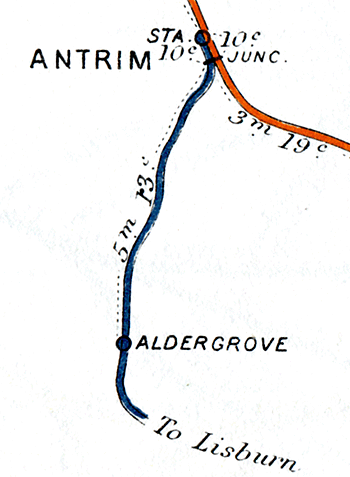 On 12 September 1960 the passenger service between Belfast Great Victoria Street and Antrim was withdrawn and all of the stations on the Antrim branch, including Aldergrove, were closed completely. The Down direction loop was removed. On 12 September 1960 the passenger service between Belfast Great Victoria Street and Antrim was withdrawn and all of the stations on the Antrim branch, including Aldergrove, were closed completely. The Down direction loop was removed.
The line had to remain open to serve goods services that ran to and from the Republic of Ireland. After 15 February 1965 when the Portadown – Londonderry line was closed additional freight traffic started to use the line as it formed the only surviving route between Londonderry and the Republic of Ireland. At this time the station was much as it had been before closure with even the name boards still present.
On 26 January 1974 a passenger service was reintroduced to the line but Aldergove station was not reopened. Its building and platforms had been demolished by this time.
Passenger services continued to run until 30 June 2003. Since that date the line has seen only occasional passenger diversions, engineering trains and special workings. The Aldergrove aerodrome was developed as the Belfast International Airport and the close proximity of the Antrim branch has given rise to the suggestion that it could be used to create a rail link to it. By 2017 no progress had been made but it remained an aspiration.
Tickets from Michael Stewart and route map by Alan Young
Sources:
- Along UTA Lines, Ulsters Rail Network in the 1960s - Ian McLarnon Sinclair - Colourpoint 2009
- Dark Days and Brighter Days for Northern Ireland Railways - Edwin McMillan - Colourpoint 2016.
- Johnson's Atlas & Gazetteer of the Railways of Ireland - Stephen Johnson - Midland Publishing 1997
- One Hundred and Fifty Years of Irish Railways - Fergus Mulligan - Appletree Press 1983.
- Railways in Ireland, Part 2 - Martin Bairstow 2007
- The Great Northern Railway, an Irish Railway Pictorial - Tom Ferris - Midland Publishing 2003
To see the GNRI Antrim branch click
on the station name: Knockmore, Knockmore Junction Halt, Brookmount, Brookhill Halt, Meeting House Halt, Ballinderry, Legatiriff Halt, Glenavy, Crumlin and Millar's Bridge Halt |


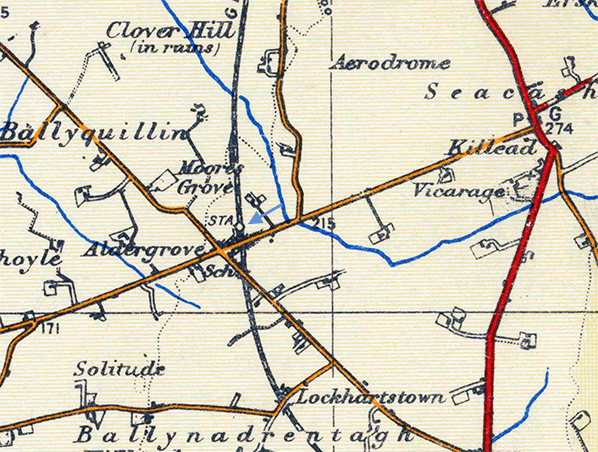
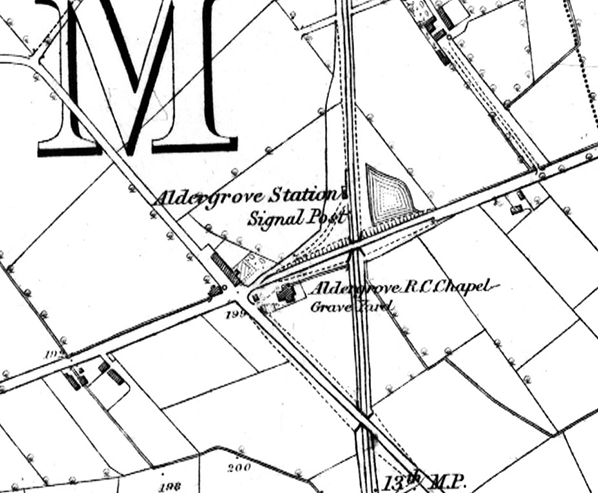



 Aldergrove station was on the north side of a lane that passed over the line on a bridge. The line was a single track railway built to the Irish standard gauge (5ft 3inch) and the station was provided with one platform located on the western side of the line. The station had goods facilities in the form of a siding located at the rear of the platform towards its northern end. There was also a cattle pen.
Aldergrove station was on the north side of a lane that passed over the line on a bridge. The line was a single track railway built to the Irish standard gauge (5ft 3inch) and the station was provided with one platform located on the western side of the line. The station had goods facilities in the form of a siding located at the rear of the platform towards its northern end. There was also a cattle pen.  During the war additional trains were run to Aldergrove for military personnel and aerodrome workers. One such service was run by the London Midland & Scottish Railway Northern Counties Committee (LMS NCC) a successor company of the B&NCR). Their working timetable supplement of 12 April 1942 showed a Monday-to-Friday departure for Cookstown Junction at 5.50pm. This train arrived at Aldergrove from Antrim as an empty stock move at 5.48pm and was given only 2 minutes to turn around. On Saturdays the departure for Cookstown was at 12.43pm the stock having arrived from Antrim at 12.40pm. On Sundays there was an LMS NCC train from Ballymena which arrived at 9.00am. It departed as empty stock at 9.10am and ran back to Ballymena. Empty stock was then departed from Ballymena at 5.10pm and arrived back at Aldergrove at 5.48pm. This stock formed the 5.50pm passenger service from Aldergrove to Ballymena which was reached at 6.40pm. There are no passenger arrivals listed on weekdays and they certainly would have been required. They were probably operated by the GNRI and would therefore not appear in the LMS NCC working timetable (click
During the war additional trains were run to Aldergrove for military personnel and aerodrome workers. One such service was run by the London Midland & Scottish Railway Northern Counties Committee (LMS NCC) a successor company of the B&NCR). Their working timetable supplement of 12 April 1942 showed a Monday-to-Friday departure for Cookstown Junction at 5.50pm. This train arrived at Aldergrove from Antrim as an empty stock move at 5.48pm and was given only 2 minutes to turn around. On Saturdays the departure for Cookstown was at 12.43pm the stock having arrived from Antrim at 12.40pm. On Sundays there was an LMS NCC train from Ballymena which arrived at 9.00am. It departed as empty stock at 9.10am and ran back to Ballymena. Empty stock was then departed from Ballymena at 5.10pm and arrived back at Aldergrove at 5.48pm. This stock formed the 5.50pm passenger service from Aldergrove to Ballymena which was reached at 6.40pm. There are no passenger arrivals listed on weekdays and they certainly would have been required. They were probably operated by the GNRI and would therefore not appear in the LMS NCC working timetable (click  On 12 September 1960 the passenger service between Belfast Great Victoria Street and Antrim was withdrawn and all of the stations on the Antrim branch, including Aldergrove, were closed completely. The Down direction loop was removed.
On 12 September 1960 the passenger service between Belfast Great Victoria Street and Antrim was withdrawn and all of the stations on the Antrim branch, including Aldergrove, were closed completely. The Down direction loop was removed. 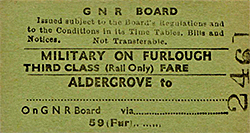
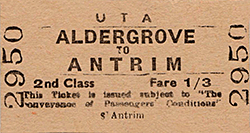



 Home Page
Home Page